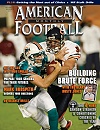AMERICAN FOOTBALL MONTHLY THE #1 RESOURCE FOR FOOTBALL COACHES
Article CategoriesAFM Magazine
|
Differentiate Your Strength Training© More from this issue
By Dr. Michael Yessis President, Sports Training, Inc.
Do your players need more concentric, eccentric or isometric strength? Or, do they need more starting strength, explosive strength, speed-strength, absolute strength, limit strength or strength endurance? If you are like most football coaches, you probably have not given much thought to the kinds of strength that the players need. This is understandable since the different types of strength are rarely discussed or differentiated. However, knowing the differences between these different types of strength and which position players need which specific types of strength can play a signif....The full article can only be seen by subscribers.
|
|
|||||||
| HOME |
MAGAZINE |
SUBSCRIBE | ONLINE COLUMNISTS | COACHING VIDEOS |
Copyright 2025, AmericanFootballMonthly.com
All Rights Reserved





